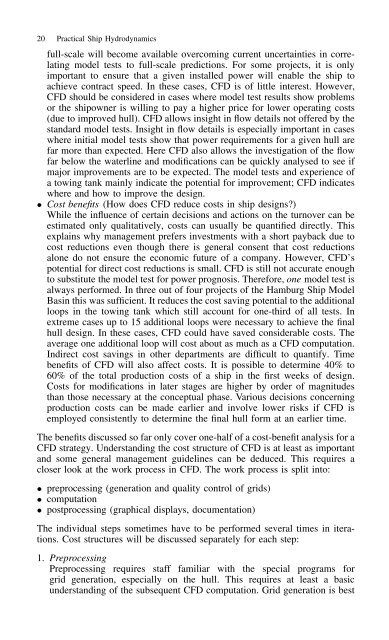Practical Ship Hydrodynamics
Practical Ship Hydrodynamics
Practical Ship Hydrodynamics
Create successful ePaper yourself
Turn your PDF publications into a flip-book with our unique Google optimized e-Paper software.
20 <strong>Practical</strong> <strong>Ship</strong> <strong>Hydrodynamics</strong><br />
full-scale will become available overcoming current uncertainties in correlating<br />
model tests to full-scale predictions. For some projects, it is only<br />
important to ensure that a given installed power will enable the ship to<br />
achieve contract speed. In these cases, CFD is of little interest. However,<br />
CFD should be considered in cases where model test results show problems<br />
or the shipowner is willing to pay a higher price for lower operating costs<br />
(due to improved hull). CFD allows insight in flow details not offered by the<br />
standard model tests. Insight in flow details is especially important in cases<br />
where initial model tests show that power requirements for a given hull are<br />
far more than expected. Here CFD also allows the investigation of the flow<br />
far below the waterline and modifications can be quickly analysed to see if<br />
major improvements are to be expected. The model tests and experience of<br />
a towing tank mainly indicate the potential for improvement; CFD indicates<br />
where and how to improve the design.<br />
ž Cost benefits (How does CFD reduce costs in ship designs?)<br />
While the influence of certain decisions and actions on the turnover can be<br />
estimated only qualitatively, costs can usually be quantified directly. This<br />
explains why management prefers investments with a short payback due to<br />
cost reductions even though there is general consent that cost reductions<br />
alone do not ensure the economic future of a company. However, CFD’s<br />
potential for direct cost reductions is small. CFD is still not accurate enough<br />
to substitute the model test for power prognosis. Therefore, one modeltestis<br />
always performed. In three out of four projects of the Hamburg <strong>Ship</strong> Model<br />
Basin this was sufficient. It reduces the cost saving potential to the additional<br />
loops in the towing tank which still account for one-third of all tests. In<br />
extreme cases up to 15 additional loops were necessary to achieve the final<br />
hull design. In these cases, CFD could have saved considerable costs. The<br />
average one additional loop will cost about as much as a CFD computation.<br />
Indirect cost savings in other departments are difficult to quantify. Time<br />
benefits of CFD will also affect costs. It is possible to determine 40% to<br />
60% of the total production costs of a ship in the first weeks of design.<br />
Costs for modifications in later stages are higher by order of magnitudes<br />
than those necessary at the conceptual phase. Various decisions concerning<br />
production costs can be made earlier and involve lower risks if CFD is<br />
employed consistently to determine the final hull form at an earlier time.<br />
The benefits discussed so far only cover one-half of a cost-benefit analysis for a<br />
CFD strategy. Understanding the cost structure of CFD is at least as important<br />
and some general management guidelines can be deduced. This requires a<br />
closer look at the work process in CFD. The work process is split into:<br />
ž preprocessing (generation and quality control of grids)<br />
ž computation<br />
ž postprocessing (graphical displays, documentation)<br />
The individual steps sometimes have to be performed several times in iterations.<br />
Cost structures will be discussed separately for each step:<br />
1. Preprocessing<br />
Preprocessing requires staff familiar with the special programs for<br />
grid generation, especially on the hull. This requires at least a basic<br />
understanding of the subsequent CFD computation. Grid generation is best
















